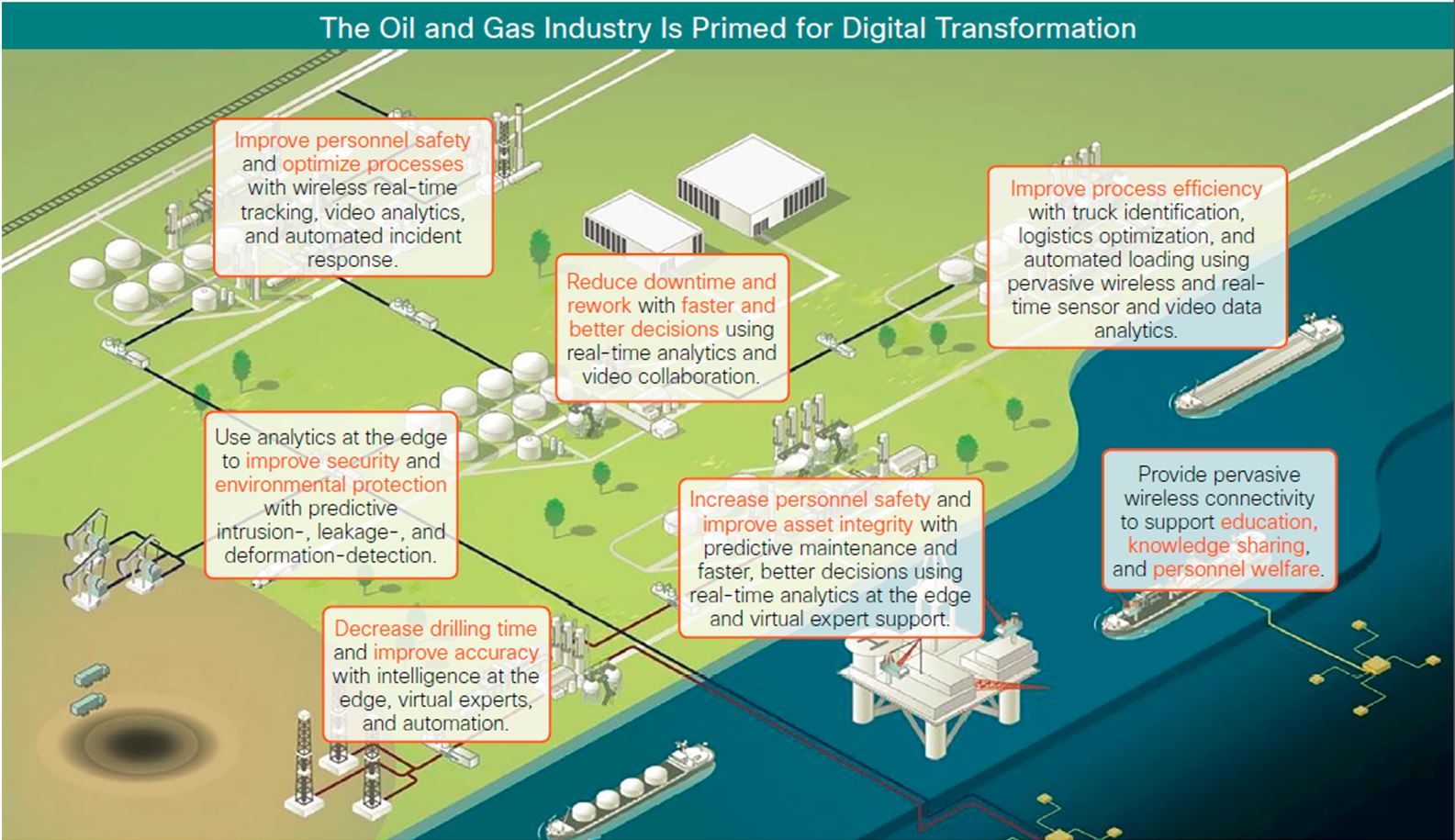































This week I'm attending CERAWeek, the premier international gathering of energy industry leaders, experts, government officials, policymakers, and innovators. While this is the 34thannual CERAWeek conference, the mood is definitely not "business as usual." The disruption and uncertainty created by plunging oil prices and shifting market dynamics has created the urgency throughout the industry to rethink strategies and adopt connected technologies to spur operational efficiencies.
But disruption can also create opportunity. Forward-thinking oil and gas (O&G) firms see today's turbulent market as an opportunity to gain competitive advantage by harnessing new technologies. For example, in the Eagle Ford region in North America, improved drilling technologies are now enabling oil rigs to produce 18 times more efficiently than in 2008, and 65 percent more efficiently than in 2013.
A new study by Cisco highlights the opportunity to achieve even greater efficiencies through transformed business models and digital technologies powered by the Internet of Everything (IoE)-the networked connection of people process, data, and things.
With IoE, oil and gas firms have the opportunity to make IT services a commodity in the business, creating the potential for dramatic cost reduction and improved operational efficiency. The illustration below shows several ways O&G operations can benefit from connected technologies. To achieve these benefits, however, they will need to bring together both the IT and the operational technology (OT) sides of the business. Our survey indicates that oil and gas firms have a long way to go in breaking down the barriers between IT and OT. In fact, only 41 percent of respondents "completely" or "somewhat" agreed that their firms' IT and OT strategies are aligned.
 Source: Cisco, 2015
Source: Cisco, 2015Here are some examples of how IT-OT convergence can impact the areas of data, collaboration, and cybersecurity:
Data: The ability for analytics to generate actionable business insights is largely dependent on the information available for analysis. Too often in the oil and gas industry, however, organizational "silos" deny or limit access to this information- severely curtailing the potential impact of data analytics for many firms. For example, an executive for major capital projects in Canada who responded to our survey remarked, "We have data, but it is poorly integrated and poorly analyzed. This makes it difficult for managers to wade through and find the information they really need." In fact, 48 percent of respondents named "data" as the area of IoE they need to improve most to make effective use of connected technologies. "Process" ranked second, at 28 percent, pointing to the need to bring IT and OT together to integrate both data and processes.
Collaboration:The disconnect between IT and OT also has an impact on the "people" aspect of IoE, hampering effective collaboration. By combining business process reengineering with IoE-enabled collaboration capabilities, O&G companies can make better and faster decisions, reduce downtime, improve productivity, and much more. For example, Westfalen Weser Energy of Germany is using video collaboration to extend the expertise of remote engineers to field technicians, significantly improving the firm's service and repair processes.
Cybersecurity: A study by Fox-IT and Oil and Gas IQ reported that 60 percent of oil and gas companies do not have a cybersecurity incident response plan, and 23 percent admitted they are not actively monitoring their network for potential intrusions. Digital transformation with IoE means that new and diverse devices are connecting to oil and gas industrial networks. IT and OT need to align their strategies and work closely together to ensure end-to-end security. Fifty-nine percent of our survey respondents listed "company information" as the area of most concern, followed by process control systems (31 percent) and IT systems (28 percent). An effective, end-to-end cybersecurity approach-including alignment between IT and OT-delivers many advantages, including increased business agility and risk awareness, lower cost of operations, and reduced downtime.
These are just three examples of how removing silos can decrease costs, increase business agility, and unleash IoE's ability to deliver business and operational benefits throughout the O&G value chain. As for the 59 percent of companies that don't yet have strategic IT-OT alignment-they should take steps now to foster a strong IT-OT partnership. In today's turbulent, uncertain O&G environment, their very survival might depend on it.
Are these your priorities? Do you have other priorities? Let me know what you think.
 Горячие метки:
кибербезопасность
Internet of Everything (IOE)
3. Анализ
#Сотрудничество в целях развития
Cisco Industrial IoT (IIoT)
digital
digital1
Disruption
CERAWeek
Горячие метки:
кибербезопасность
Internet of Everything (IOE)
3. Анализ
#Сотрудничество в целях развития
Cisco Industrial IoT (IIoT)
digital
digital1
Disruption
CERAWeek